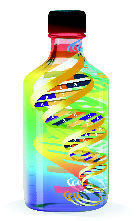In his book, The Blooding (1989), Joseph Wambaugh described the first use of DNA testing in a criminal investigation. As it turned out, the new type of forensic analysis unveiled a rapist-killer in an unusual way. The police collected blood samples for DNA testing from every male between the ages of 16 and 34, living in the vicinity of the crime scenes. To dodge the test, a cake decorator named Colin Pitchfork paid a coworker to donate blood for Pitchfork. After the police learned about the ruse, they arrested Pitchfork, who confessed to the crimes.
Since then, DNA testing has become routine in both criminal and civil cases. Readers of mystery and crime fiction expect DNA analysis to play some role in a story set in modern times. One good source for basic information on DNA testing is the U.S. Department of Justice’s DNA for the Defense Bar. As the title indicates, the guide is particularly useful if your main character is a defense attorney who must confront damaging DNA evidence. The book is available at the National Institute of Justice website.

